The OnePlus 2 Review
by Brandon Chester on December 14, 2015 8:00 AM EST- Posted in
- Smartphones
- Mobile
- OnePlus
- OnePlus 2
System Performance
The OnePlus 2 uses Qualcomm's Snapdragon 810 SoC. At this point we've seen Snapdragon 810 in a number of devices and have an idea of what to expect. That being said, we've seen that performance can vary based on the device it's implemented in due to cooling and other factors like the CPU governor. On top of that, in many situations a device's performance is heavily dependent on the quality of its software in addition to the processing power of its SoC. For those reasons it's important to run the OnePlus 2 through our standard suite of web and native benchmarks in order to gauge its performance relative to other Snapdragon 810 smartphones, and the rest of the smartphone market as a whole.
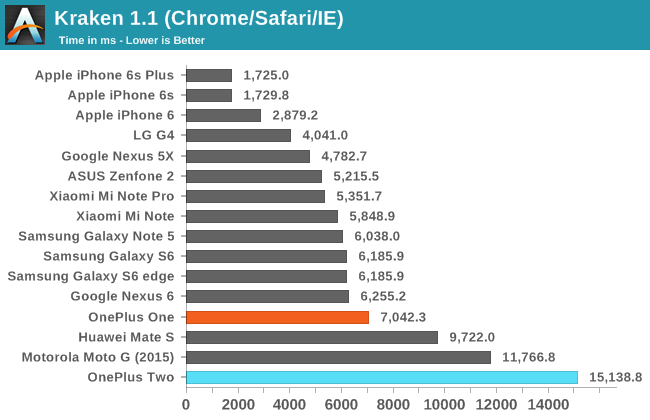
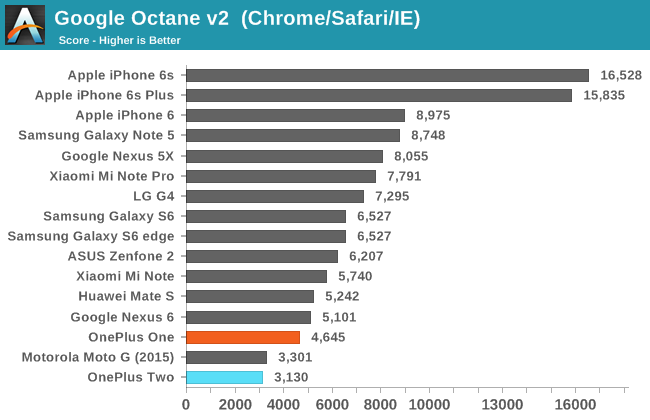
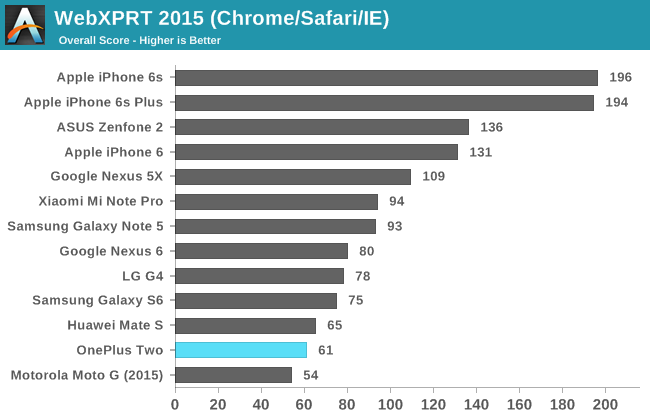
When I saw the web performance results from the OnePlus 2 I assumed there had been some sort of error, so I decided to completely reset the phone and run them again. Unfortunately, these results are not erroneous. You may have noticed that they bear a remarkable similarity to the results from the Moto G (2015). After looking at the CPU activity during web browsing I realized that this isn't really surprising, because the OnePlus 2 simply does not use any of its Cortex A57 cores during web browsing. This means that you're really getting a quad core Cortex A53 CPU, and with JavaScript being heavily bound by the performance of a single core it's no wonder that the results are close to those of the Moto G (2015) which uses a quad core 1.4GHz Cortex A53 CPU.
I don't really want to retread the Snapdragon 808 and 810 topic, but it's really worth noting that this is the worst implementation of the SoC I've seen to date. It's worth noting that this doesn't say anything about the length of time the A57 cores can run for when they do actually get used, but it shows that they're not getting used in circumstances where they should be: bursty workloads where the full performance of the CPU is needed for a short period of time to improve the user experience. It's especially concerning because OnePlus was making a great deal of noise about their work to manage thermals on Snapdragon 810. I personally don't think simply not using the big cores on an SoC constitutes properly managing its temperature, and the poor JavaScript performance truly does make browsing the web feel like using a slower and much less expensive phone like the Moto G.
Update:
There has been some concern online that these web browsing results may be inaccurate. The evidence to the contrary has been in the form of results from other reviews, results using other ROMs or kernels, or using other web browsers. To clarify, these scores were achieved using the latest version of Oxygen OS for the OnePlus 2, which is 2.1.2, in the latest version of Google Chrome. The reason for the scores is that OnePlus is specifically detecting whether or not Chrome is the active application, and if that is the case they unplug all of the Cortex A57 cores, regardless of the load being placed by both Chrome and background applications. Below I have embedded a video that demonstrates this behavior.
In this circumstance I launched a CPU load virus with 4 threads in order to cause Snapdragon 810's Cortex A57 cores to reach peak clocks. CPU4 through CPU7 represent the Cortex A57 cores, while CPU0 and CPU1 are two of the Cortex A53 cores, with the other two tracking at the same frequencies but not being shown on screen in order to accommodate my fingers. You can obviously see the clocks of the A57 cores dropping as heat becomes an issue, but that's not really the focus here. What is the focus is how all four cores shut off the moment Chrome is opened. This is clear evidence that OnePlus has hard coded this behavior. Whether or not it was introduced in more recent releases of Oxygen OS is hard to say, but given that users report achieving greater scores a few months ago this is very possible. It's also important to note that this behavior only affects Chrome, and results from the Chrome Dev or Chrome Beta channels are unaffected.
While the OnePlus Two is technically capable of faster browser performance, the performance users will actually see using the only browser included on the device is reflected accurately in the results we have published, and not at all accurately by any results other users are achieving with different kernels that modify the CPU behavior, or different releases of Chrome that aren't detected by OnePlus's software. With that in mind, I see no reason to alter the results that have been published, as they accurately characterize the JavaScript performance that most OnePlus Two users will experience.
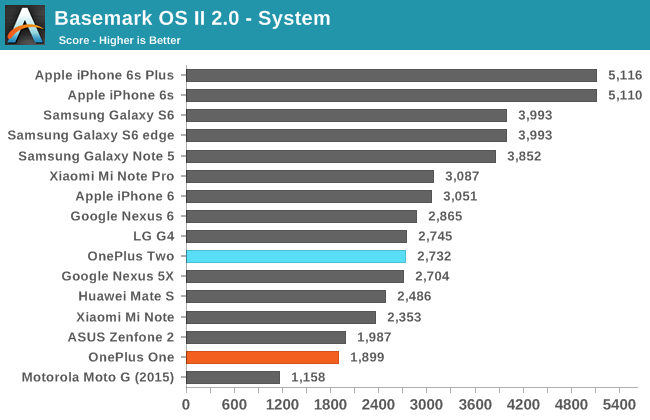
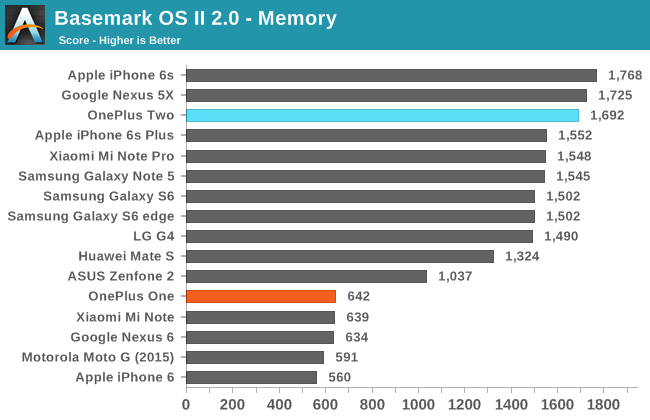
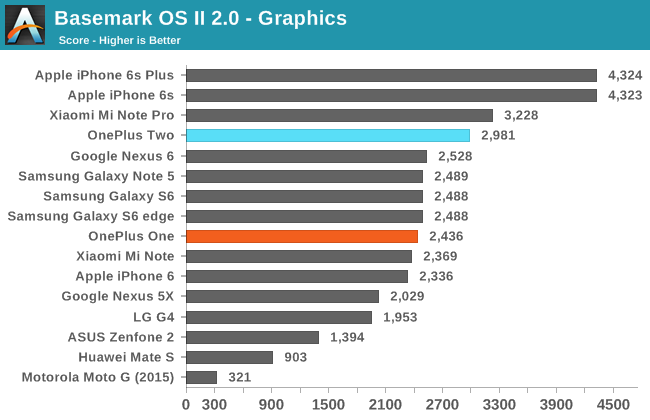
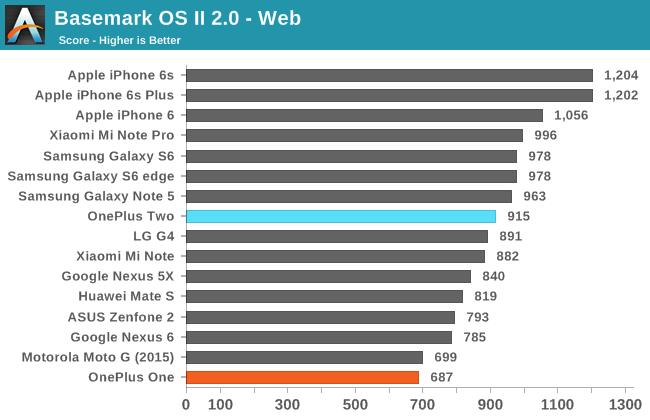
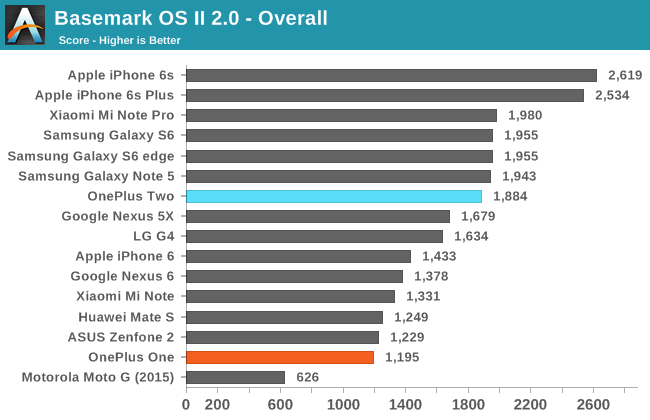
BaseMark OS II is a case where the Cortex A57 cores on the OnePlus 2 actually see some use, which translates into higher relative scores than what was achieved in browser testing. Improved scores in the graphics and NAND memory tests help make the overall score significantly higher than the OnePlus One. It's worth noting that the use of the Cortex A57 cores means that the BaseMark results may not be exactly representative of how the phone will actually perform in general use. For example, in this case the Cortex A57 cores are in use during the web test, while in general they never get used at all during web browsing, and in more intensive situations the best case is that there are two A57 cores in use at some frequency and the other two are shut off.
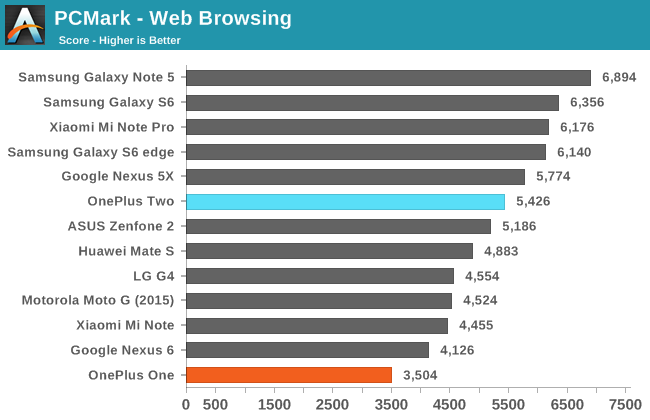
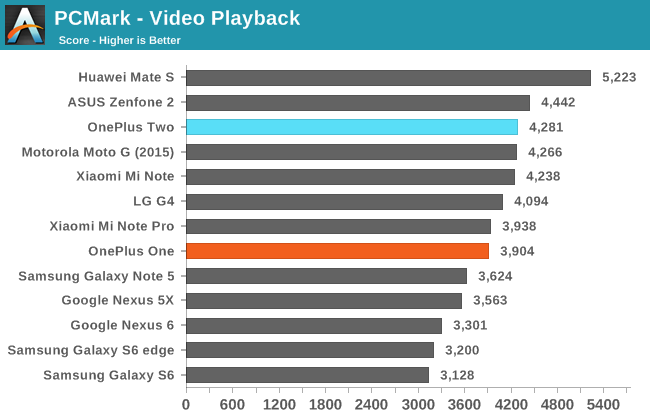
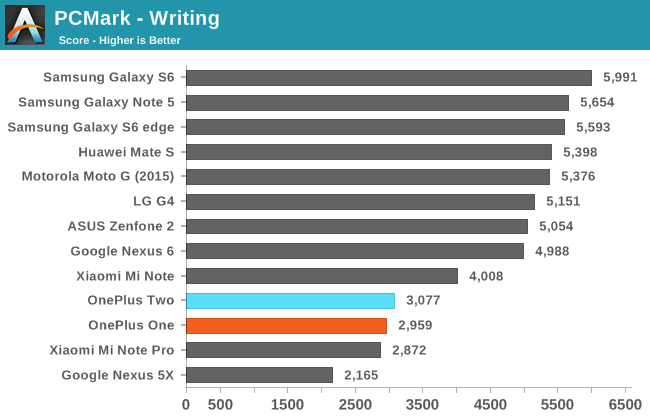
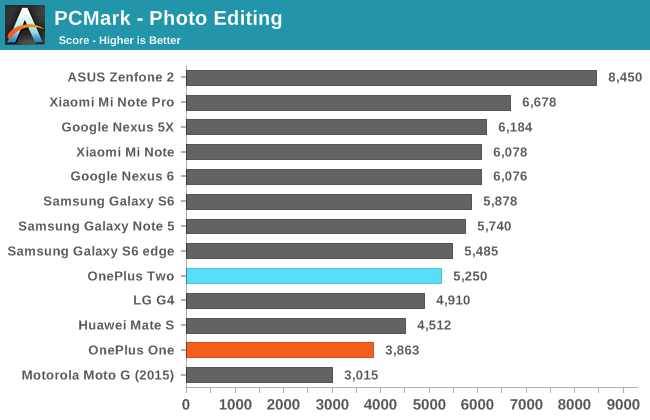
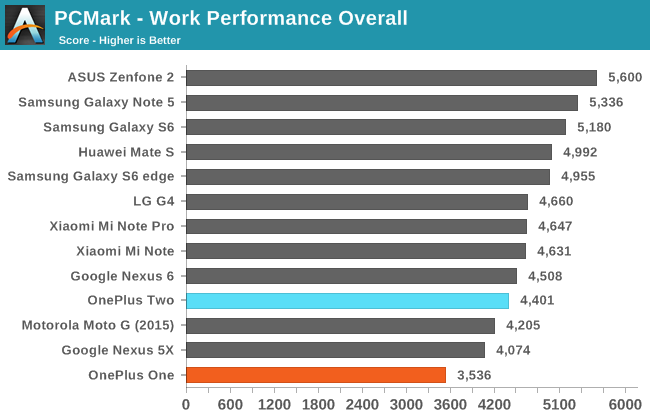
In PCMark the OnePlus 2 again does better in the web tests due to the fact that the A57 cores actually switch on, but falls behind in the photo editing test and even more so in the writing test. The writing test is actually a fairly good indicator of CPU performance, because it involves decompressing text files, moving text from one file to another, adding text and images, and then saving them to disk. During that entire period the A57 cores are not triggered at all, which contributes to the low score. Even with that, it's not exactly clear to me what additional factors make the Snapdragon 808 and 810 devices all perform so poorly here compared to a device like the Moto G which just has 4 Cortex A53 cores. It could very well be the result of issues with ART, or other problems with frequency scaling on the A53 cluster. In any case, like all Snapdragon 808 and 810 devices, the OnePlus 2 struggles in the aspects of the test that heavily tax the CPU.
The issues with Snapdragon 808 and 810 have led to many issues with CPU performance this year across a number of Android phones. However, OnePlus is the only company I can remember publicly stating that they had worked to overcome these issues, and the fact that the OnePlus 2 falls so far behind other 808 and 810 devices in the web browsing puts a lot of doubt in the validity of those remarks. It's pretty safe to say that if you care about CPU performance you're much better off with the OnePlus One or OnePlus X, both of which use Snapdragon 801, and if you're thinking about buying the OnePlus 2 you really need to take the performance issues into consideration because they're on a different scale than those on other recent smartphones. At $400 there's a lot of competition, and the CPU and JavaScript performance on the OnePlus 2 just doesn't measure up.










132 Comments
View All Comments
grayson_carr - Monday, December 14, 2015 - link
Here's my review. I owned a Moto X Pure for a couple months. Then I got a Nexus 5X. Now I'm selling the Moto X Pure. The Moto X Pure is fast in the sense that it opens and switched between apps quickly, but slow in the sense that its GPU has a tough time pushing that QHD resolution and it often has trouble maintaining a high framerate when scrolling in apps. The Nexus 5X is the opposite, which I vastly prefer. The 5X takes a little longer to open apps than the Moto X Pure, but it feels much smoother when scrolling in most apps and is better at maintaining a high framerate. Also, the Nexus 5X has an awesome fingerprint sensor, a vastly better camera in low light, faster updates, and a better calibrated screen (even with the Moto X Pure display in standard mode and not vivid). Battery life is similar between the two. The two things the Moto X Pure does have going for it over the Nexus 5X is build quality (which is very solid) and the speakers (which are excellent).Landiepete - Friday, December 18, 2015 - link
I can do that right now for you.1. It does not have a ingerprint scanner so if you absolutely want one, walk away.
2. It doe not have wireless charging, so if you feel plugging it in to a wall socket is too much trouble walk away.
What it DOES do :
1. With marshmallow, battery life is about 2 days for me. If you use it intensively, I gather you will have to charge it every day
2. The screen is excellent
3. It's not metal, but it does not feel cheap
4. The memory card is a great way to increase storage without paying the premium handset manufacturers charge for built in storage
5. It DOES get warm to the touch if you use the fast cores, like when it upates or you use 4K filming, but it won't burn your paws
6. Contrary to popular belief, the 808 is NOT too slow for the quad res screen. Caveat : I do not use it as a gameboy.
7. Near stock droid, so no crapware or bloatware. I don't edit movies on my Phone.
8. Very good camera
9. It still has the usual USB connector, so your old chargers and car kits still work
Conclusion : unless your prime goal is to sollicit oohhhs and aaaahhhs from onlookers, I thoroughly recommend it.
Pete
aijazz - Monday, December 14, 2015 - link
would be great to get a much awaited nexus 6p review.Devo2007 - Monday, December 14, 2015 - link
Given how late this review is, you'll probably be waiting until February.... :PBrandon Chester - Monday, December 14, 2015 - link
The Nexus 6P review is being done by Andrei and is almost complete. Look for it this week.mcbhagav - Monday, December 14, 2015 - link
<bait> Moto X Pure seems to be favorite among the kinda of users visit your site </bait>amdwilliam1985 - Monday, December 14, 2015 - link
thank you for the heads up, looking forward to the 6P review.I'm so glad I've got the 6P instead of OP2 :)
When in doubt, go with Nexus ;)
zeeBomb - Tuesday, December 15, 2015 - link
Thusday / Friday, lets get it!Nexus6P - Monday, December 14, 2015 - link
Maybe one day a review of me will be posted.LemmingOverlord - Monday, December 14, 2015 - link
You, Sir, are in that unique classe of "smartassphones" :D